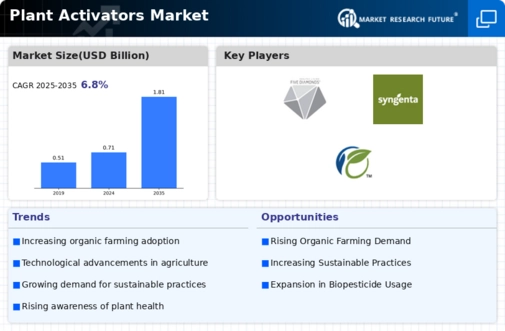Market Analysis
In-depth Analysis of Plant Activators Market Industry Landscape
A variety of market factors determine the characteristics and growth potential of the Plant Activators Market Size. Sustainable agriculture techniques are becoming more important worldwide. As environmental awareness rises, farmers are using plant activators to boost crop resilience and minimize synthetic chemical use. Sustainable and eco-friendly agricultural techniques drive plant activators market growth.
Plant activators, produced from biological or chemical sources, help plants defend against biotic and abiotic stress. Plant activators are expected to generate USD 880 million by 2024, growing at 6% CAGR. Pest infestations, drought, heat, and fungal and bacterial diseases cause major agricultural production losses, driving plant activator market growth. Growing farming technology and integrated pest management strategies fuel industry growth. Increased agriculture expenditure, especially in affluent nations, may further explain plant activator sales worldwide. However, product scarcity in numerous developing countries and farmers' excessive use of chemical alternatives hinder market expansion. Due to growing knowledge of plant activators and agriculture investments, active suppliers might profit from the market despite these hurdles.
Climate change and agriculture also affect market size. Farmers are seeking crop protection measures due to weather uncertainty and the rise in catastrophic occurrences like droughts and pests. Plant activators help plants resist environmental challenges by boosting their natural defenses. This increased crop protection need drives the plant activator market.
Demand for organic products and pesticide-free agricultural techniques drive industry expansion. Farmers seeking to satisfy organic product demand are using plant activators, which are organic-friendly. Plant activators are used due to consumers' increased food awareness and demand for residue-free crops, affecting market size.
Agriculture technology and plant science research and development shape the plant activators market. New formulations and application strategies boost plant activator efficacy. These improved solutions encourage farmers to embrace them, growing the market.
Agriculture and agricultural protection laws also affect plant activators market size. Sustainable agricultural standards and synthetic chemical prohibitions urge farmers to use plant activators. Conversely, regulatory impediments or unclear norms might hinder market expansion.
Globalization and market interconnection affect plant activators market size. Farmers across areas are adopting comparable agricultural techniques because to better knowledge and technology, resulting to increased plant activator usage. International research and development partnerships spread knowledge and technology, increasing market growth.






Leave a Comment